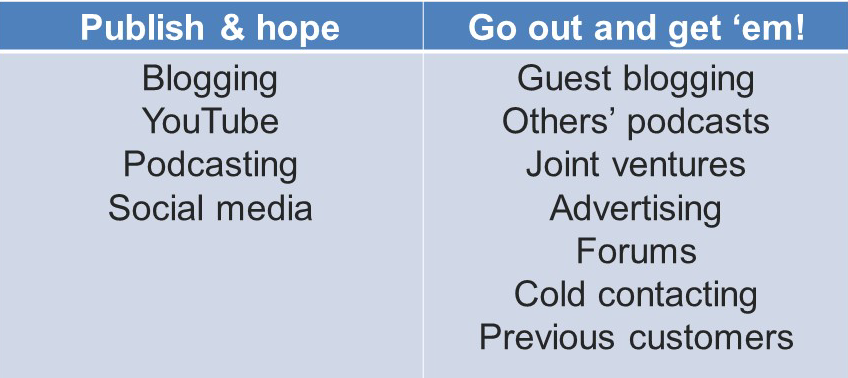Notes:
Last week’s episode was about things I did “right” in my business, which made it grow. I’m saying the word “right” with air quotes, because keep in mind that what works for one person’s business might not work for another. Today I want to look at the flip side – things that failed or didn’t work out like I’d hoped. I’ll talk about five of them today – the first two are sort of mindset-related, and the last three are more tactical.
1. I was too insecure at the beginning to reach out and get in front of others’ audiences
I remember that in the early days of my business, getting people to come to the site was like pulling teeth. I’d log in to my analytics every day (not a productive use of my time, by the way) and there’d be tumbleweeds. In the second month, I wrote this in my journal:
“Man… I started well, but my site and following is still so small. Getting to where I want to be seems so far away!”
I struggled with building traffic for the next 6-9 months – I’d blog and blog and the site just didn’t seem to be growing very fast. But now I understand that I wasn’t putting myself out there enough at all.
When you put a website online, there are two main approaches you can take when it comes to getting traffic:

When I started, all I was doing was blogging. That’s it. Oh, and I followed 2,000 people on Twitter… that was about as proactive as I got. The “publish and hope” strategy worked… but it took a LONG time and was very frustrating.
What I should have done was BOTH publishing AND actively going out and getting my stuff in front of people. I was shy, I had an inferiority complex, but I wish someone more experienced than me had told me to suck it up and just do it, because my site would have grown a lot faster.
So if you’re frustrated with lack of traffic, take some action! Come up with 10 things you could do to get in front of your target audience. If they don’t read blogs, maybe they hang out on forums – so go participate and be helpful. Are there established websites that serve a similar audience? Offer to run a free webinar for them, or produce a useful guide or video they can publish.
There’s cold calling… there’s direct mail… maybe save up some money and invest it in advertising (there’s FB ads, Google ads, Twitter ads, YouTube ads, banner ads on related websites, even print ads – try several types and see what works for getting you traffic.)
Don’t be nervous. My best advice is not to fear putting yourself and your product out there. Contact as MANY communities/people as you possibly can, even if it’s a long shot. This is what I didn’t do in the beginning b/c I was too insecure, and I wish I had done it.
2. Wasted mental energy and time on worrying if it was working; played the comparison game
Here’s another journal excerpt from my first year that perfectly captures how discouraged I was at the time. It hurts to read this now – but it really reflects my mindset at the time!
“I’m afraid I’m pouring all my effort into something that won’t take off. Only 3 people signed up for the deeply discounted pronunciation course; who am I to think I can get hundreds of customers per month? Is it that I’m not drawing enough traffic and I need to increase it exponentially? Or is what I’m offering just not intriguing or unique or useful enough?”
I was constantly worrying about “is this working?” and also comparing myself to the case studies I was reading. So I’d read articles about six-figure course launches, and then try to do the same things, and my first course launch got… about 18 people at $30 each. It would make me doubt everything.
I’m not even sure how I kept going; I think it was just the fact that the alternative was worse – namely, working for dirt-cheap wages in offline schools and spending hours commuting to those classes on the hot, crowded bus.
What I wish I’d adopted is the mindset of a scientist – and I should have known this, because my background is in science. I should have viewed each effort simply as an experiment, and kept myself emotionally detached from it – so if one thing didn’t work as well as I’d hoped, just analyze it, try to improve, and run another experiment instead of spiraling into worry and despair.
3. Spent $$ on ads to cold prospects… with a low-priced product
OK, so when I did have some courses that had sold well to my e-mail list, I figured – time to scale up! Let’s run some ads. I’d calculated out my average conversion rates and I thought this was it – this would be some guaranteed growth.
So I spent a couple thousand dollars on Google and Facebook ads. I didn’t send them straight to a sales page; I sent them to an opt-in page for my e-mail list – and conversion was good at about 33%. Then as they started getting my e-mails, I waited for the sales to roll in… and they didn’t. It just wasn’t moving the needle, and meanwhile money was continuing to pour into those ads.
I took a closer look at the numbers, and fortunately, I had tagged “ad-acquired” subscribers so I could analyze them separately from my organically-acquired subscribers. And I discovered that the people who came onto the list via ads converted into paying customers at less than half the rate of my organic subscribers. The result was that the campaigns didn’t even come close to breaking even. For every $1,000 spent on ads, I recovered only about $350 in sales.
Now, the numbers would have worked if I had a higher-priced product – if I was selling something in the $500-$1000 range, then those ads would have turned out very profitable – but my products are in the sub-$100 range. So if you have a high-priced product, it’s worth investing in creating ads and a solid sales funnel.
The other thing I should have done was not just to throw the subscribers from ads into my normal e-mail list, but instead to send them a special autoresponder sequence that focused specifically on educating them into a sale. People who find me organically are already searching for a solution; they also build a relationship with me over time and are more likely to buy.
But for people coming in through the ads, they were sort of interested but they didn’t really know, like, or trust me yet. And I hadn’t really educated them on my products and how my products could meet their needs.
So that was a few thousand dollars mostly down the drain, but it was a valuable learning experience – and I’m glad I was tracking the numbers so that I could realize when it wasn’t working!
4. Launched a monthly subscription with a very general/vague value proposition
Monthly recurring revenue is often considered like the “holy grail” of business. Software companies use it, paid subscriptions and paid membership communities use it, nowadays even physical products with subscription boxes and businesses that send you shampoo and snacks and whatnot at regular intervals.
All of my previous products were one-time purchases, so I wanted to try a monthly paid subscription program. I created something called Premium Lessons that was supposed to be an all-in-one continuous learning program. All my other courses zero in on a particular aspect of the language, like “vocabulary” or “pronunciation” – but this program was going to have it all. Can you see the potential problem here?
I launched it with great fanfare and 150 people signed up, which I thought was a success at the time. I was sending out the lessons, subscribers were enjoying them, and most were staying in the program. But a few months in, I realized that new people were NOT signing up for it. I tried to do a mini-relaunch and that was a total flop, with less than 10 new members.
What I realized was that I hadn’t nailed a specific benefit for this program. An “all-in-one” learning solution is really general… it doesn’t capture your attention, make you sit up and say “wow, I definitely need that!” As I looked over the names of the people who had bought it, I realized that these were my “superfans,” people who had purchased multiple things from me in the past and would probably buy anything I put out just because they love me.
Of course it’s great to have fans like that! But the value proposition clearly wasn’t attracting most people, and I was even feeling “meh” about it – so I ended up shutting the program down. I’ll do a future episode specifically on that whole project, because it was an interesting case study.
5. Webinars… and why I’m bringing them back
For a while there was a big webinar craze. Maybe it’s still going on, I’m not sure – I’m not following as many blogs nowadays. But in the thick of it, people were saying that webinars were THE BEST way to convert people into customers, and there were all sorts of businesses running very profitable webinar funnels.
So I thought, “Woohoo! This is a great fit for my teaching business, I’m gonna do a webinar every month and supercharge my sales.”
So I scheduled my first webinar and promoted it heavily to my list (which was getting pretty big by this point) and 1200 people signed up! I was like “Woohoo, this is gonna be awesome!”
Well, despite reminder emails and whatnot only 300 of those people showed up. Still pretty good, right?
Well, out of those 300 people, only 3 bought on the webinar.
I tried a few more webinars over the following months, with similar results. The floodgates didn’t exactly open, and it was taking me a lot of time to prepare for each presentation, since I wanted them to be good, right? So I stopped. It wasn’t the game-changer I thought it would be.
In hindsight, I now know that some of the people who are making a killing on webinars use extreme scarcity – like you can get a $1000 product for $500, but ONLY if you buy before the end of the webinar – stuff like that. I’m usually not such a high-pressure seller, so I wasn’t using those tactics.
My webinar experiment was two years ago and I haven’t done one since, but now I’m actually thinking of bringing them back – not so much as a direct sales vehicle, but rather just for relationship-building. People buy things from businesses and people who they know, like, and trust, and webinars – or even simpler things like Facebook Live – can be great for building that relationship and connecting with your audience without the hard sell. I won’t be able to measure the results with hard numbers, but I believe it can make a difference.
I hope you’ve enjoyed hearing about my failures, dead ends, and lessons learned – if you’d like to share any of yours, visit entrepreneursinmotion.com/failures to leave a comment!


